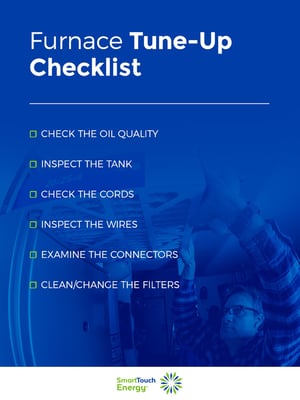For many homes in the United States, an oil furnace is the preferred source of heat. As a natural source of warmth, an oil furnace can provide well-distributed warmth throughout all the rooms in a house. For the furnace to work when you need it most, you must have it serviced at least once per year. The following reasons best summarize the importance of furnace maintenance.
Maintain Healthy Oil Quality
Why get a furnace inspection? With annual furnace inspections, you can ensure the quality of the oil supply. For the furnace to perform at its full capacity, the tank must be full of high-quality oil to combust that fuel into gas for your heating system. With healthy fuel, the overall system should remain in proper order because the fuel will burn clean and not leave harmful traces or emit noxious fumes. A furnace inspector will know the correct color and consistency of a healthy fuel supply. The inspector should also let you know if your fuel supply is too low and whether you should order refills more often.
Prevent Oil Contamination
When furnace inspectors check your fuel, they will also be able to identify lingering problems with your oil supply, such as residue, rust or trace elements that could degrade the fluid and harm the system. If the oil is dirty, the problem could link to other factors, such as moisture, corrosion or stray dirt within the tank. If you or a previous owner left your furnace unused for a lengthy period, you might have had a lingering, dirty oil supply mixed with newer oil. The inspector should run an oil test to check for contamination and determine whether you need to replace your oil supply.
Prevent Moisture Buildup
Humidity can have a damaging effect on a furnace, especially in cold environments where lingering moisture makes its way into the system. If condensation lines the interior walls of your furnace, it could lead to corrosion and the spread of rust. A tank could be especially vulnerable if the oil supply stays at a low level, as this creates space within the tank for the moisture to corrode the inner metal linings. A furnace technician will be able to tell whether moisture is affecting your furnace and what changes you should make to reduce moisture levels in and around the furnace.
Avoid Forgetting Maintenance
When you stick to an annual service schedule, the maintenance of your furnace becomes an automatic process that will always happen during a select month. Without this annual ritual, you could easily lapse on maintenance intervals and possibly forget when you last had the furnace inspected by a technician. If you rarely use the furnace, the thought of service might never cross your mind until a problem arises. With a service inspection every 12 months, a tech can bring performance issues to your attention and remedy them promptly, regardless of whether you rely on the furnace daily, or only use it occasionally.

Maintain Proper Air Flow
For your heating system to effectively distribute warmth throughout your house during the fall and winter, the furnace must facilitate the proper flow of air. With an annual furnace inspection, you can help ensure proper airflow for as long as you use the furnace. Each year, a service technician should examine the passages of your heating system to make sure everything flows as it should, free of dust, dirt or other obstructions.
Prevent System Strain
With a properly flowing furnace, you can help prevent obstructions from building up within the system that might otherwise put a strain on if. For the furnace to work correctly, it must be able to generate heat from the fuel within the tank. If the passages get obstructed with dirt, gunk or oily residue, the airflow could become restricted as it attempts to travel to the heat ducts throughout your house. Over time, this can inflict damage on the system. Annual service maintenance can help you prevent strain on the heating system.
Avoid Costly Repairs
The purpose of preventive furnace maintenance is to catch minor issues before they turn into major ones that could ultimately damage your heating system. For example, if you clear a dirty passageway before the problem spirals out of hand, you can prevent damage to the motor of your heating unit. On the other hand, if you let the problem persist, the furnace might strain itself just to pass heat to the various quarters of your house. If the problem goes unchecked and the strain becomes more and more intense, it could ultimately cause the furnace to buckle under pressure. You can avoid such issues with an annual furnace check.
Ensure Safety
For a furnace to work correctly, it must be able to carry out the process of fuel combustion. Otherwise, gases could fester inside the tank and ultimately emit toxins, either indoors or directly outside, depending on the type of tank in question. To keep this process functioning as designed, you must have annual maintenance inspections to ensure the mechanisms of your furnace remain precise.
Prevent Leaks
An unchecked oil furnace can develop leaks that could ultimately lead to more severe dangers. To prevent this from happening, you must have annual maintenance performed to halt the spread of corrosion on the tank or any of the attached system components. Otherwise, issues such as faulty connectors or rust formation could take hold in certain areas. In many cases, these problems occur out of sight.

While it is wise to give your furnace a once-over from time to time, it is best to enlist the trained eyes of a service technician to spot and diagnose leaks and other types of damage. That way, you can usually have the problem fixed before it necessitates costly parts replacement or leads to a complete system failure.
Save Time
When you stick to an annual schedule of furnace maintenance, you can have most problems diagnosed quickly. The best time of year for this is during the late weeks of summer, right before the colder fall and winter months. In the summertime, furnace technicians typically have open schedules because most homeowners are not even thinking about using their heat during this time of the year. If you wait until the mercury drops, you could find yourself on a waiting list as more people book the nearby service companies.
Avoid Unexpected Breakdowns
During the spring and summer, you might never turn on your heater. If the warm seasons are long and humid in your area, your furnace might go six or seven months without any use. Consequently, the furnace and the heating system will be in hibernation during this time. It is, therefore, crucial to find out whether the furnace will still be in functioning order once you do power the unit on for the winter. Otherwise, you could have the furnace fail at the worst possible time.
With timely, annual furnace inspections, you can avoid untimely failures of your heating system. Due to the high volume of work orders furnace technicians get in the middle of winter, it is crucial to have your furnace checked before the weather gets cold.
Boost Heating Efficiency
With a functioning furnace, your heating system as a whole will work smoothly and distribute heat more evenly with minimal wear and tear. If you allow the furnace to carry on unchecked, however, the system could slowly deteriorate and strain harder and harder to perform its essential functions. Over time, this could render your heating system less efficient because you would ultimately find yourself cranking the heat for longer periods at high temperatures to maintain the warmth within your house. As such, maintenance neglect could cause your energy bills to spike, whereas annual inspections and maintenance can help you save money during the cold seasons.
Maintain Manufacturer’s Warranty
If your furnace is still under warranty, you can stretch that warranty period out as long as possible by having the unit inspected periodically. Not doing so could nullify your warranty, as most manufacturers consider a warranty null and void if the owner does not properly maintain the unit. With annual furnace inspections, you could end up discovering issues that might be grounds for an exchange of the unit. Inspections, in effect, can help you save money. If a problem comes to light, it could be a blessing in disguise that would lead to you trading up for a better furnace.
Clean the Filters
One part of your heating system you should have inspected quarterly are the filters, which need to be clean and free of dust to enable the free flow of air. During your annual inspection, the service tech will check the filters and recommend new ones if necessary. Then again, a filter is one of the easier system parts to inspect on your own with little DIY experience. Every few months, check each filter for dust deposits and clean as needed.

Inspect the Cords and Wires
Get the cords that connect to your furnace inspected each year for signs of distress. If the furnace has been subject to inclement weather or humidity, the cords could have gotten damaged if openly exposed to the elements. While you're at it, get the wires within the circuitry of the furnace motor inspected for signs of distress. If there is any damage to the wires, it could render the furnace dangerous to operate. A service technician will know how to spot these defects and make or recommend the proper changes.
How Often Should You Have a Furnace Serviced?
If you are wondering how often to service your furnace, consider how much you rely on the unit for heat and comfort. If you use the furnace modestly during the fall and winter months, the annual inspections you schedule with your local service techs should be sufficient to maintain the unit’s health and functionality for the natural lifespan of the make/model in question. If you rely on your furnace day in and day out throughout most of the year, you should have the unit inspected more often, preferably every three or four months.
When you rely on your oil furnace in the fall and winter, but keep it turned off for the spring and summer, you are effectively using the furnace for half of each year. If your use of the furnace is modest, such as only a couple of hours per day during the colder months, any wear and tear should be mild, and therefore, you should have no reason to expect any major influx of dirt, dust, rust and fuel contamination. As long as you have the unit checked each year, such issues should be minor enough to remedy with low-cost solutions.
If, however, you use the furnace two to three times more frequently, you'll be putting it through more work, and it should undergo maintenance more than once during the colder months.
The Best Time to Service a Furnace
There is never a wrong time to service a furnace. Whenever the unit displays performance issues or a considerable length of time has passed since the last inspection, it is time to call your local maintenance specialist. That said, some times of the year are more favorable for furnace inspections, namely the summer months, when demand is low for furnace maintenance and technicians will often come to your house at reduced rates.
Once the colder season gets underway, more homeowners are turning on their furnaces, only to discover performance issues. Consequently, service techs are busier in the fall and often have their schedules booked during winter. Homeowners who skimp on service and go several years without maintenance will usually have a furnace fail just when they need it most, such as when the outside weather drops to subzero levels.
If you suddenly find yourself without a working furnace during the holiday season, you could ultimately end up on a service waiting list for several days. You would also likely pay more for a furnace inspection during winter. However, you could avoid these situations by having your furnace serviced in advance of winter.
Furnace Tune-Up Checklist
During each visit by a furnace service tech, the unit should undergo a thorough inspection to ensure everything is in proper working condition and that the oil and filters are clean and free-flowing. Overall, each inspection should entail the following tasks:
- Check the oil quality
- Inspect the tank
- Check the cords
- Inspect the wires
- Examine the connectors
- Clean/change the filters
If the inspection discovers any problems, act immediately before the costs and damages accumulate.
Schedule a Furnace Inspection From Smart Touch Energy
If your furnace appears to be in optimal working condition, now could be the best time to have a service professional inspect it. If the inspection brings any issues to light, you could have the matter remedied before a more noticeable set of problems arise. Moreover, you could be better prepared to handle the situation because it won’t catch you off-guard. For homes and businesses in the northeast U.S., Smart Touch Energy is the trusted name in furnace maintenance. Contact us today to schedule a service inspection of your oil furnace.



